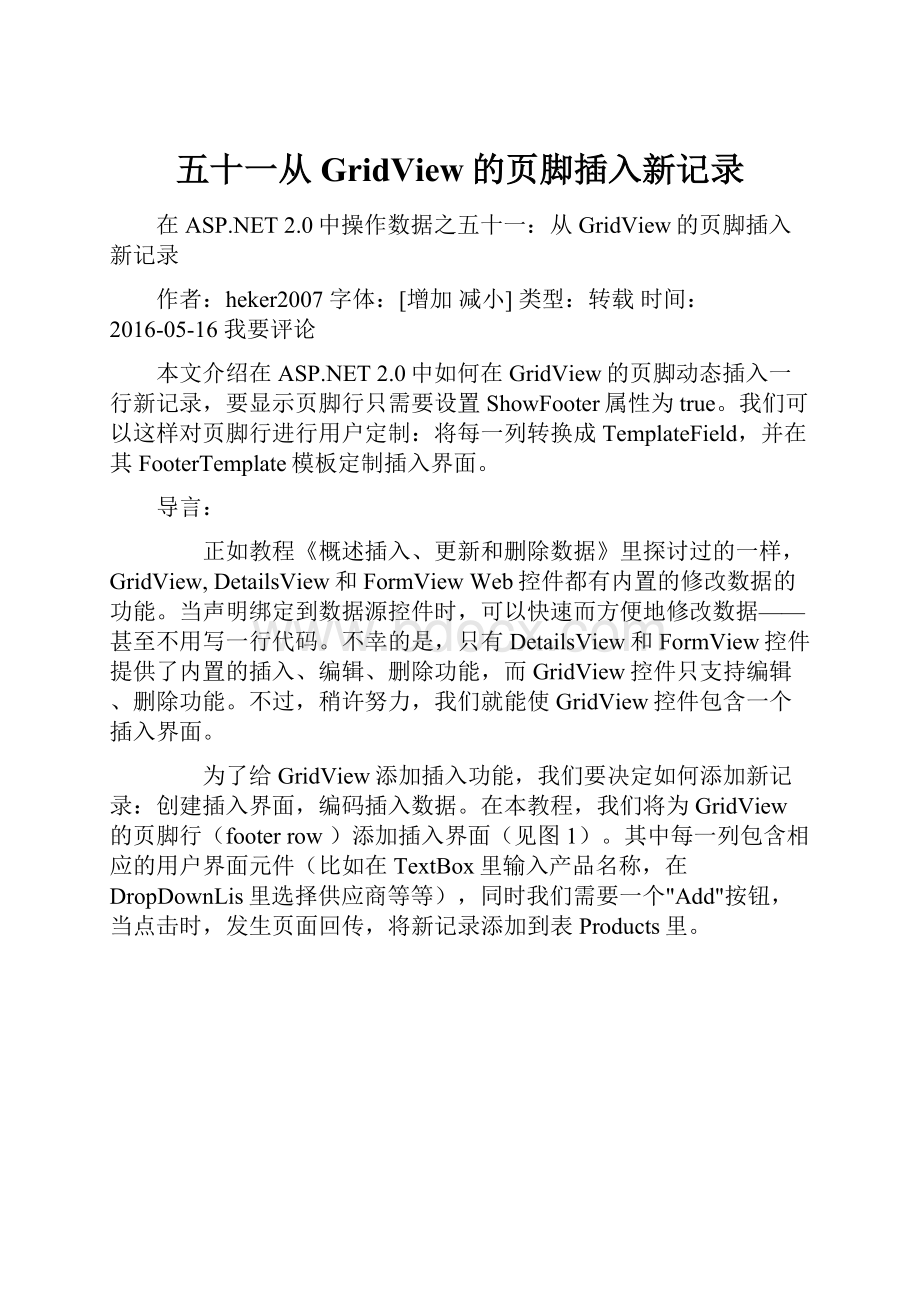五十一从GridView的页脚插入新记录.docx
《五十一从GridView的页脚插入新记录.docx》由会员分享,可在线阅读,更多相关《五十一从GridView的页脚插入新记录.docx(31页珍藏版)》请在冰豆网上搜索。

五十一从GridView的页脚插入新记录
在ASP.NET2.0中操作数据之五十一:
从GridView的页脚插入新记录
作者:
heker2007字体:
[增加 减小]类型:
转载时间:
2016-05-16 我要评论
本文介绍在ASP.NET2.0中如何在GridView的页脚动态插入一行新记录,要显示页脚行只需要设置ShowFooter属性为true。
我们可以这样对页脚行进行用户定制:
将每一列转换成TemplateField,并在其FooterTemplate模板定制插入界面。
导言:
正如教程《概述插入、更新和删除数据》里探讨过的一样,GridView,DetailsView和FormViewWeb控件都有内置的修改数据的功能。
当声明绑定到数据源控件时,可以快速而方便地修改数据——甚至不用写一行代码。
不幸的是,只有DetailsView和FormView控件提供了内置的插入、编辑、删除功能,而GridView控件只支持编辑、删除功能。
不过,稍许努力,我们就能使GridView控件包含一个插入界面。
为了给GridView添加插入功能,我们要决定如何添加新记录:
创建插入界面,编码插入数据。
在本教程,我们将为GridView的页脚行(footerrow)添加插入界面(见图1)。
其中每一列包含相应的用户界面元件(比如在TextBox里输入产品名称,在DropDownLis里选择供应商等等),同时我们需要一个"Add"按钮,当点击时,发生页面回传,将新记录添加到表Products里。
图1:
页脚行提供了一个添加新记录的界面
第一步:
在GridView控件里展示产品信息
首先添加一个展示产品的GridView控件。
打开EnhancedGridView文件夹里的InsertThroughFooter.aspx页面,在上面添加一个GridView控件,设其ID为Products,然后,在其智能标签里绑定到一个名为ProductsDataSource的ObjectDataSource。
图2:
创建一个名为ProductsDataSource的新ObjectDataSource
设置该ObjectDataSource调用ProductsBLL类的GetProducts()方法获取产品信息。
在本教程里,我们只关注于添加插入功能,与编辑和删除无关。
所以,确保在“插入”选项卡里选AddProduct()方法。
而在“编辑”和“删除”里选“(None)”。
图3:
将ObjectDataSource的Insert()方法设置为AddProduct()
图4:
在UPDATE和DELETE选项里选“(None)”
完成设置后,VisualStudio会自动添加相关列。
现在,我们暂时不管这些列,在教程后续部分,我们将移除一些列,因为在添加新记录时我们不需指定这些列的值。
因为数据库中大概有80个产品,所以我们最好还是启用分页功能,以便使插入界面更直观、更易操作。
回到页面,在GridView的智能标签里启用分页。
现在,GridView和ObjectDataSource的声明代码看起来和下面的差不多:
?
1
2
3
4
5
6
7
8
9
10
11
12
13
14
15
16
17
18
19
20
21
22
23
24
25
26
27
28
29
30
31
32
33
34
35
36
37
38
39
40
41
42
43
44
45
46
47
GridViewID="Products"runat="server"AutoGenerateColumns="False"
DataKeyNames="ProductID"DataSourceID="ProductsDataSource"
AllowPaging="True"EnableViewState="False">
BoundFieldDataField="ProductID"HeaderText="ProductID"
InsertVisible="False"ReadOnly="True"
SortExpression="ProductID"/>
BoundFieldDataField="ProductName"HeaderText="ProductName"
SortExpression="ProductName"/>
BoundFieldDataField="SupplierID"HeaderText="SupplierID"
SortExpression="SupplierID"/>
BoundFieldDataField="CategoryID"HeaderText="CategoryID"
SortExpression="CategoryID"/>
BoundFieldDataField="QuantityPerUnit"HeaderText="QuantityPerUnit"
SortExpression="QuantityPerUnit"/>
BoundFieldDataField="UnitPrice"HeaderText="UnitPrice"
SortExpression="UnitPrice"/>
BoundFieldDataField="UnitsInStock"HeaderText="UnitsInStock"
SortExpression="UnitsInStock"/>
BoundFieldDataField="UnitsOnOrder"HeaderText="UnitsOnOrder"
SortExpression="UnitsOnOrder"/>
BoundFieldDataField="ReorderLevel"HeaderText="ReorderLevel"
SortExpression="ReorderLevel"/>
CheckBoxFieldDataField="Discontinued"HeaderText="Discontinued"
SortExpression="Discontinued"/>
BoundFieldDataField="CategoryName"HeaderText="CategoryName"
ReadOnly="True"SortExpression="CategoryName"/>
BoundFieldDataField="SupplierName"HeaderText="SupplierName"
ReadOnly="True"SortExpression="SupplierName"/>
GridView>
ObjectDataSourceID="ProductsDataSource"runat="server"
InsertMethod="AddProduct"OldValuesParameterFormatString="original_{0}"
SelectMethod="GetProducts"TypeName="ProductsBLL">
ParameterName="productName"Type="String"/>
ParameterName="supplierID"Type="Int32"/>
ParameterName="categoryID"Type="Int32"/>
ParameterName="quantityPerUnit"Type="String"/>
ParameterName="unitPrice"Type="Decimal"/>
ParameterName="unitsInStock"Type="Int16"/>
ParameterName="unitsOnOrder"Type="Int16"/>
ParameterName="reorderLevel"Type="Int16"/>
ParameterName="discontinued"Type="Boolean"/>
ObjectDataSource>
图5:
在一个启用了分页功能的GridView里,显示产品的所有数据项
第2步:
添加一个页脚行
GridView控件包含页眉行、数据行和页脚行。
GridView控件ShowHeader和ShowFooter属性决定了是否显示页眉行和页脚行。
如果要显示页脚行,我们需要将ShowFooter属性设置为true。
如图6所示:
图6:
设ShowFooter属性为True,添加页脚行
我们注意到页脚行的背景色是深红色,这是由于我们在教程《使用ObjectDataSource展现数据》里创建了一个名为DataWebControls的主题,并将其应用为所有的页面底色。
特别的,皮肤文件GridView.skin设置FooterStyle属性使用FooterStyleCSS,其代码如下:
?
1
2
3
4
5
6
.FooterStyle
{
background-color:
#a33;
color:
White;
text-align:
right;
}
注意:
在以前的教程我们提到过使用GridView的页脚行。
如果不清楚的话,请查阅教程第15章《在GridView的页脚中显示统计信息》
设置ShowFooter属性为true后,在浏览器里观看效果。
当前的页脚行并不包含任何的文字或Web控件。
在第3步,我们将修改其包含相应的插入界面。
图7:
页脚行显示为空白
第3步:
自定义页脚行
回顾教程《在GridView控件中使用TemplateField》,在那篇教程我们探讨了如何对GridView的某一列使用TemplateFields(而不是BoundFields或CheckBoxFields),从而实现自定义显示样式;而在教程《定制数据修改界面》里我们看到如何在GridView里使用TemplateFields定制编辑界面。
一个TemplateField是由诸如ItemTemplate、EditItemTemplate等模板构成的。
比如,ItemTemplate模板显示的数据行为只读状态;而EditItemTemplate模板定制了一个编辑行界面。
除了ItemTemplate、EditItemTemplate等模板外,TemplateField也包含一个名为FooterTemplate的模板,它为容器指定页脚行。
所以我们可以在FooterTemplate模板里添加插入界面要用到的Web控件。
让我们开始吧,首先,我们将GridView控件里的所有列转换成TemplateFields。
在GridView控件的智能标签里点击“编辑列”,在左边选中每个域,再点击“ConvertthisfieldintoaTemplateField”。
图8:
将每个域转换为一个TemplateField
点击“ConvertthisfieldintoaTemplateField”的话,将当前类型的域转换成相应的TemplateField。
比如,每个BoundField将转换成这样的TemplateField,它的ItemTemplate包含一个Label控件来显示相应的数据域;它的EditItemTemplate使用一个TextBox控件来显示相应的数据域。
例如,在这里,名为ProductName的BoundField将被转换为如下所示的TemplateField:
?
1
2
3
4
5
6
7
8
9
10
TemplateFieldHeaderText="ProductName"SortExpression="ProductName">
TextBoxID="TextBox1"runat="server"
Text='<%#Bind("ProductName")%>'>
TextBox>
LabelID="Label2"runat="server"
Text='<%#Bind("ProductName")%>'>
Label>
TemplateField>
同样的,名为Discontinued的CheckBoxField转换为TemplateField后,其ItemTemplate和EditItemTemplate模板都将包含一个CheckBoxWeb控件(只是ItemTemplate模板里的CheckBox不可用);而处于“只读”状态的ProductIDBoundField转换成TemplateField后,其ItemTemplate和EditItemTemplate模板都包含一个Label控件。
简而言之,将GridView里的某一列转换为一个TemplateField,是定制自定义模板的一种又快又容易的方法,且不会丧失该列应有的功能。
由于我们不需要GridView支持编辑功能,将每个TemplateField的EditItemTemplate模板删除,只留下ItemTemplate模板。
完成后,GridView的代码看起来应和下面的差不多:
?
1
2
3
4
5
6
7
8
9
10
11
12
13
14
15
16
17
18
19
20
21
22
23
24
25
26
27
28
29
30
31
32
33
34
35
36
37
38
39
40
41
42
43
44
45
46
47
48
49
50
51
52
53
54
55
56
57
58
59
60
61
62
63
64
65
66
67
68
69
70
71
72
73
74
75
76
77
78
79
80
81
82
83
84
85
86
GridViewID="Products"runat="server"AutoGenerateColumns="False"
DataKeyNames="ProductID"DataSourceID="ProductsDataSource"
AllowPaging="True"EnableViewState="False"ShowFooter="True">
TemplateFieldHeaderText="ProductID"InsertVisible="False"
SortExpression="ProductID">
LabelID="Label1"runat="server"
Text='<%#Bind("ProductID")%>'>
Label>
TemplateField>
TemplateFieldHeaderText="ProductName"SortExpression="ProductName">
LabelID="Label2"runat="server"
Text='<%#Bind("ProductName")%>'>
Label>
TemplateField>
TemplateFieldHeaderText="SupplierID"SortExpression="SupplierID">
LabelID="Label3"runat="server"
Text='<%#Bind("SupplierID")%>'>
Label>
TemplateField>
TemplateFieldHeaderText="CategoryID"SortExpression="CategoryID">
LabelID="Label4"runat="server"
Text='<%#Bind("CategoryID")%>'>
Label>
TemplateField>
TemplateFieldHeaderText="QuantityPerUnit"
SortExpression="QuantityPerUnit">
LabelID="Label5"runat="server"
Text='<%#Bind("QuantityPerUnit")%>'>
Label>
TemplateField>
TemplateFieldHeaderText="UnitPrice"SortExpression="UnitPrice">
LabelID="Label6"runat="server"
Text='<%#Bind("UnitPrice")%>'>
Label>
TemplateField>
TemplateFieldHeaderText="UnitsInStock"
SortExpression="UnitsInStock">
LabelID="Label7"runat="server"
Text='<%#Bind("UnitsInStock")%>'>
Label>
TemplateField>
TemplateFieldHeaderText="UnitsOnOrder"
SortExpression="UnitsOnOrder">
LabelID="Label8"runat="server"
Text='<%#Bind("UnitsOnOrder")%>'>
Label>
TemplateField>
TemplateFieldHeaderText="ReorderLevel"
SortExpression="ReorderLevel">
LabelID="Label9"runat="server"
Text='<%#Bind("ReorderLevel")%>'>
Label>
TemplateField>
TemplateFieldHeaderText="Discontinued"
SortExpression="Discontinued">
CheckBoxID="CheckBox1"runat="server"
Checked='<%#Bind("Discontinued")%>'Enabled="false"/>
TemplateField>
TemplateFieldHeaderText="CategoryName"
SortExpression="CategoryName">
LabelID="Label10"runat="server"
Text='<%#Bind("CategoryName")%>'>
Label>
TemplateField>
TemplateFieldHeaderText="SupplierName"
SortExpression="SupplierName">
LabelID="Label11"runat="server"
Text='<%#Bind("SupplierName")%>'>
Label>
TemplateField>
GridView>
现在,每个GridView列都已经转换成一个TemplateField,我们在其FooterTemplate里添加适当的插入界面。
然而,有些列没有插入界面(比如ProductID),其它列的TemplateField模板将包含Web控件,供用户输入产品信息。
在GridView的智能标签里点击“EditTemplates”,从下拉列表里选择某列的FooterTemplate模板,从工具箱里拖一个适当的控件到页面上。
图9:
在每列的FooterTemplate里添加适当的插入界面。
下面列出了GridView的所有列,并指定每列添加哪些插入界面:
ProductID–无
ProductName–添加一个TextBox,ID为NewProductName;再添加一个
RequiredFieldValidator控件,防止用户未输入产品名。
SupplierID–无
CategoryID–无
QuantityPerUnit–添加一个TextBox,ID为NewQuantityPerUnit
UnitPrice–添加一个TextBo